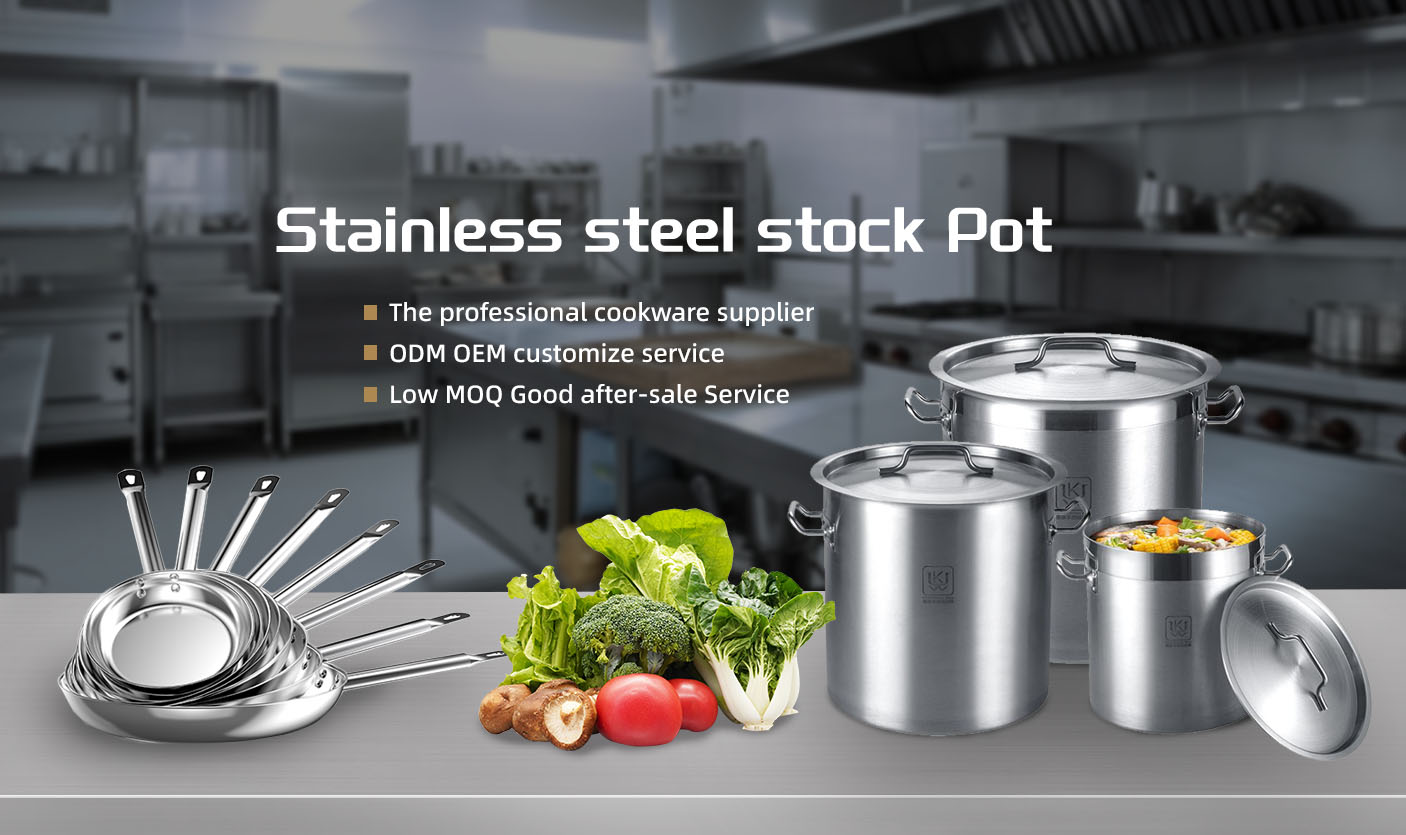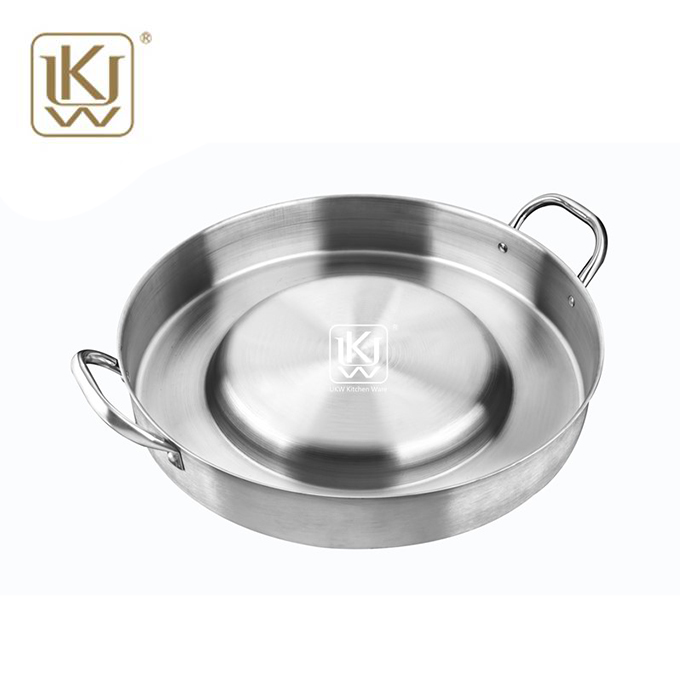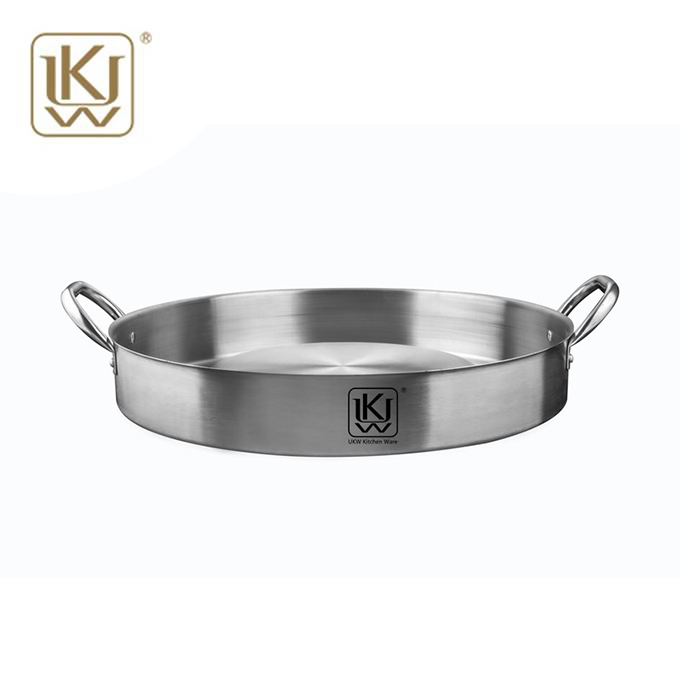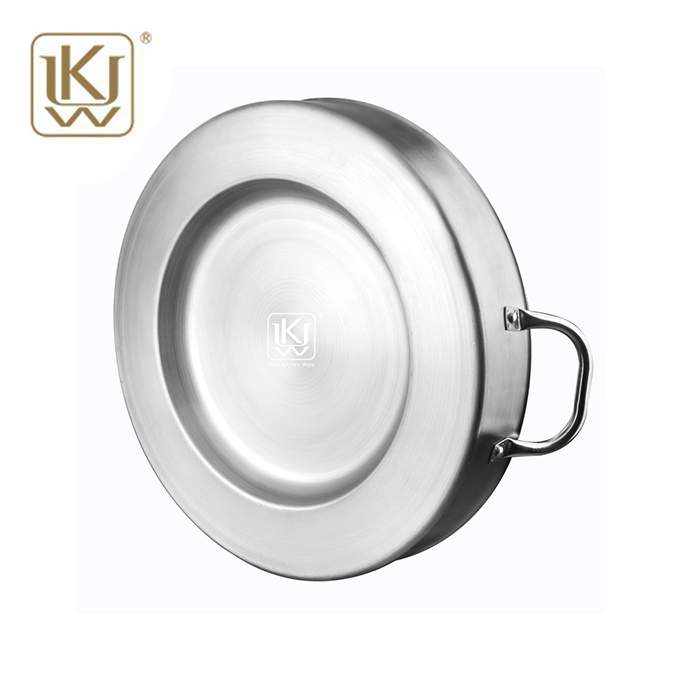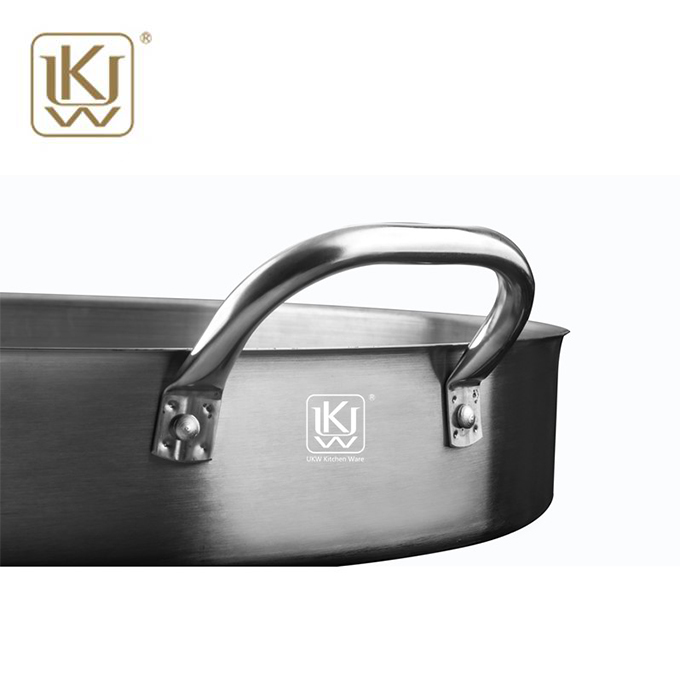Kitchen Convex Frying Pan
- Product Information
convex frying pan is a high-end kitchen cooking utensil. Its unique convex design and high-quality stainless steel material bring users an excellent cooking experience. It not only has excellent non-stick performance and uniform heat conduction ability, but also can adapt to a variety of cooking methods, such as frying, stir-frying, boiling, deep-frying, etc. Its polished surface is not only beautiful, but also effectively reduces food residue and makes cleaning easier. The convex frying pan is suitable for various heat sources, including gas stoves, electric stoves and induction stoves, providing great convenience for home and professional kitchens.
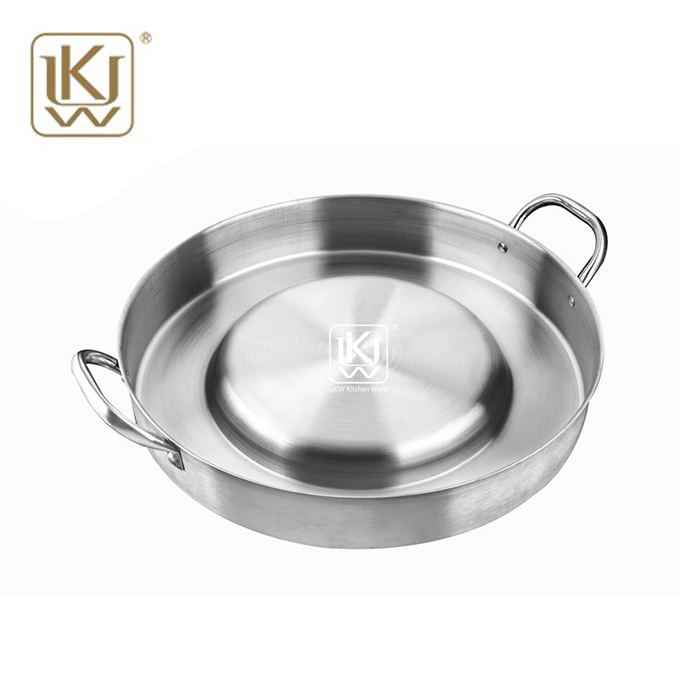
Convex Frying Pan Parameters:
| CODE | Dimension(mm) | Thick(mm) |
| CU540055 | Ф540*H55 | 1.2 |
| CU540100 | Ф540*H100 | 1.2 |
Convex Frying Pan Features:
1. High-quality materials
The Convex Frying Pan is made of high-quality stainless steel with a tensile strength of 400-500 MPa, 16%-24% chromium and 8%-12% nickel, and has excellent corrosion and oxidation resistance. Actual tests show that the corrosion resistance of the pan in a simulated kitchen environment is 7-8 times higher than that of ordinary carbon steel pans. This material ensures that the pan is not easily deformed or damaged during long-term use, and its performance and appearance can remain stable even if it is frequently exposed to acidic or alkaline ingredients. For example, when cooking acidic foods such as ketchup, ordinary carbon steel pans may corrode, leaving obvious rust and scratches on the surface, while this stainless steel pan can remain bright and new, extending its service life. The low-maintenance nature of stainless steel means that users do not need to perform special maintenance frequently, and only daily cleaning is needed to keep the pan in good condition, providing users with more lasting cooking support.
2. Precise thickness
The pot body is 1.2mm thick, which ensures that the pot body is strong and durable while also enabling it to conduct heat quickly and evenly. Tests show that this thickness allows the pot to be heated evenly in a short period of time, with the temperature difference controlled within a very small range, effectively avoiding the situation where the food is partially overcooked or undercooked. Such a thickness design can also reduce energy consumption and improve cooking efficiency. In actual use, compared with a pot with a thickness of 1.0mm, a pot with a thickness of 1.2mm is only 5% slower in heating speed, but performs significantly better in preventing deformation and evenly transferring heat, effectively reducing energy waste by 30%. For example, when frying a thick steak, a pot with a thickness of 1.2mm can ensure that the steak is evenly heated from top to bottom, forming a perfect charred crust on the surface while keeping the inside juicy and tender, while a thinner pot may cause the steak to be over-charred on the surface while the inside is not fully cooked, affecting the taste and nutritional value.
3. Various sizes
The Convex Frying Pan is available in two sizes: 540mm diameter, 55mm height and 540mm diameter, 100mm height. The larger height design is suitable for cooking processes that require more space, such as frying or stewing dishes with sauces; the standard height is suitable for daily cooking, such as omelettes or pancakes. The 540mm diameter provides users with ample cooking area to cook multiple ingredients at the same time. For example, when making a family breakfast, a large-sized pan can fry multiple eggs and bacon at the same time, improving cooking efficiency and meeting the needs of the whole family. For professional chefs, a large-sized pan can also easily handle batch cooking tasks, such as frying multiple steaks or pancakes at a time in a restaurant kitchen, ensuring the quality and taste of each dish is consistent, significantly improving the work efficiency and speed of the kitchen.
4. Food-grade safety
The pan meets food-grade safety standards such as FDA and LFGB, and does not contain harmful substances such as lead and cadmium. This means that during the cooking process, no toxic substances will be precipitated, ensuring the safety of food. Users can use this pan to cook and serve food without worrying about health issues. For example, long-term use of ordinary coated pans may cause the coating to fall off, which in turn allows harmful substances to enter the food, while this stainless steel pan completely avoids this risk and provides users with a healthier cooking environment. In actual testing, the pan passed a rigorous chemical migration test. After 1,000 hours of continuous use under high temperature conditions, it can still maintain stable chemical properties, and no release of harmful substances was detected, providing reliable food safety guarantees for families.
5. Non-stick coating
The convex pan uses advanced non-stick coating technology inside, and the coating hardness exceeds HV300, which can resist the wear of metal kitchen utensils. Actual tests show that the coating can still maintain stable performance at a high temperature of 250°C and is not easy to fall off or decompose. This non-stick property greatly reduces the amount of oil required for cooking, which helps users achieve a healthy diet and simplifies the cleaning process. For example, when frying chicken breast, an ordinary pan may require more oil to prevent sticking, but this pan only needs a small amount of oil or even no oil, and can easily fry crispy and tender chicken breast, reducing oil intake and being healthier. In addition, the low friction coefficient of the non-stick coating allows food to slide freely in the pan, making it easier to stir-fry without causing food to break due to sticking to the pan. It is particularly suitable for making dishes such as fried eggs and fried dumplings that need to maintain their shape intact.
6. Uniform heat conduction
The high thermal conductivity of stainless steel combined with the convex design achieves excellent heat distribution. Test results show that the temperature difference of the pan during use can be controlled within 5%, which is much lower than the 10% - 15% temperature difference of traditional pans. This feature ensures that food is heated evenly during the cooking process, whether it is frying eggs or stir-frying, you can get the ideal cooking effect. For example, when frying pancakes, the uniform thermal conductivity makes the bottom of the pancake golden and crispy, while the inside is soft and cooked, avoiding partial over-burning or undercooking. Uniform heat distribution can also reduce the need for monitoring during the cooking process. Users do not need to frequently adjust the fire or turn the food, saving time and energy, while improving the success rate of cooking and the taste of food.
7. Fine Surface Treatment
The surface of the Convex Frying Pan is polished and pickled to present a mirror-like smooth texture. The surface roughness after polishing is less than 0.8 μm, which not only looks exquisite, but also reduces the adhesion of food residues, making cleaning easier. The pickling treatment further improves the corrosion resistance of the pan, extending the service life of the pan by removing surface impurities and forming a protective oxide layer. For example, after cooking acidic foods such as ketchup, ordinary pans may retain stubborn stains, which are difficult to clean and may damage the coating, while the smooth surface of this pan makes stains easy to rinse off, reducing cleaning time and effort. In addition, the mirror-like appearance shows a high-end texture in the kitchen, enhances the pleasure of the cooking experience, and makes users feel comfortable and satisfied during use.
8. Ergonomic Design
The two sides of the pan are equipped with sturdy stainless steel handles, which are designed in accordance with ergonomic principles and comfortable to hold. The handles are connected to the pan body through sturdy rivets and can withstand the weight of the pan body and food. Due to the low thermal conductivity of stainless steel, the handles do not overheat during cooking, providing users with a safe and comfortable experience. For example, when frying or stir-frying for a long time, the comfortable handle design can reduce hand fatigue, increase the pleasure of cooking, and allow users to focus more on making food. In addition, the length and angle of the handles have been carefully considered to ensure that users can easily operate when flipping or moving the pot, without causing inconvenience or safety hazards due to handles that are too short or too long. This detailed design reflects the full attention to user experience and makes the cooking process smoother and more efficient.
Convex Frying Pan Application:
1. Home kitchen cooking
In the home kitchen, the Convex Frying Pan has become an ideal choice for daily cooking due to its non-stick performance and uniform heat conduction characteristics. Users can easily fry eggs, make pancakes, etc. in the pan without worrying about food sticking to the pan or uneven heating. Its food-grade safety also allows home users to prepare healthy food for their families with confidence. According to user feedback, cooking with this pan can shorten the cooking time of food by about 15% - 20%, while reducing the generation of oil smoke and making the kitchen environment cleaner. For example, to make a perfect fried egg, an ordinary pan may take 3 - 4 minutes, while this pan only takes 2 - 2.5 minutes, and the egg yolk is complete and the egg white is golden, which improves cooking efficiency and food quality. In addition, the large capacity design of the pan can meet the needs of family gatherings. Multiple dishes can be fried at a time, reducing the trouble of frequent replacement of pots, making home cooking easier and more enjoyable.
2. Restaurant kitchen application
In restaurant kitchens, the Convex Frying Pan can meet the needs of efficient cooking. Its sturdy construction and excellent heat conductivity enable chefs to cook large amounts of food quickly and evenly. For example, when making fried rice or frying meat dishes, the pan can ensure the consistent quality and taste of each dish. After using this pan, the restaurant has increased its cooking efficiency by about 20% - 25%, which helps to cope with the order pressure during peak hours. For example, in a medium-sized western restaurant, the chef needs to make more than 200 fried eggs every day. After using this pan, the yield of fried eggs has increased from 85% to 95%, significantly reducing the loss caused by uneven cooking. In addition, the non-stick coating of the pan reduces the cleaning time and the frequency of kitchenware replacement, reduces the operating costs of the restaurant, and improves the overall economic benefits.
3. Hotel kitchen use
Hotel kitchens need to prepare a large amount of food to meet the needs of guests. The large size design and uniform thermal conductivity of the convex pan make it an ideal choice for hotel kitchens. Hotel chefs can use this pan to cook multiple breakfast foods, such as fried eggs and pancakes, at the same time to ensure the quality and taste of the food. In addition, the non-stick coating and easy-to-clean features of the pan also reduce the workload of kitchen cleaning and improve overall work efficiency. For example, the kitchen of a five-star hotel needs to prepare breakfast for 500 guests every day. After using this pot, the preparation time of breakfast is shortened by about 30 minutes, and the cleaning time is reduced by 20 minutes, which significantly improves the operating efficiency of the kitchen. The pot can also withstand the high-intensity use environment of the hotel kitchen, maintain stable performance for a long time, and provide reliable cooking equipment support for the hotel.
4. Cooking school teaching
Cooking schools need reliable equipment to demonstrate various cooking techniques during the teaching process. The uniform heat conduction and non-stick properties of the convex pan make it an ideal tool for teaching. Teachers can easily demonstrate cooking techniques such as frying and stir-frying, and students can have a good learning experience in practice. Using this pot for teaching, the students' cooking success rate is significantly improved, which helps to improve the teaching quality and students' learning effect. For example, in a French crepe course in a cooking school, the success rate of crepes made by students using this pot increased from 60% to 85%, making it easier for students to master cooking skills and enhancing their confidence in learning. In addition, the durability and easy cleaning of the pot reduce the maintenance cost of teaching equipment, allowing schools to focus more on optimizing and improving teaching content.
5. Outdoor Cooking and Camping
For outdoor cooking and camping enthusiasts, the durability and versatility of the convex pan make it an ideal outdoor cooking tool. The stainless steel material can withstand various challenges of the outdoor environment, such as humidity and temperature changes. The non-stick surface of the pan makes it easy to clean in outdoor conditions, and the performance of the pan can be maintained even when cleaning supplies are scarce. Users can easily make a variety of delicious foods outdoors, such as omelettes or pancakes, and enjoy the fun of outdoor cooking. For example, when camping in the wild, use this pan to fry freshly caught fish, the fish meat is intact and the surface is golden and crispy, adding deliciousness to outdoor dining. In addition, the portability and sturdiness of the pan make it an essential tool for outdoor adventures and picnics, providing stable cooking performance regardless of the environment.
6. Specialty Food Preparation
The convex pan performs well in making specialty foods, such as French crepes and Japanese Okonomiyaki, which require precise temperature control and even heating. The pan can ensure that the crepes are evenly heated and have a delicate taste; when making Okonomiyaki, its large cooking surface and uniform heat distribution help to make a complete dish. After using this pan, specialty restaurants have significantly improved the success rate and presentation of dishes, enhancing the competitiveness of the restaurant. For example, when a specialty restaurant made Okonomiyaki, after using this pan, the finished product rate of the dish increased from 70% to 90%, and the taste was more uniform, which was well received by customers. In addition, the non-stick performance of the pan makes it easier to demould specialty foods, maintaining the integrity and aesthetics of the dishes, and improving the restaurant's product quality and customer satisfaction.
Convex Frying Pan Maintenance:
1. Daily cleaning
After each use of the Convex Frying Pan, rinse it immediately with warm water to remove any remaining food residue. For stubborn stains, use a mild detergent and a soft sponge to clean it. Avoid using strong corrosive detergents or steel wool to avoid scratching the non-stick coating. Tests show that the non-stick coating of a pan cleaned with a mild detergent and a soft sponge lasts about 30% longer than that of a pan cleaned with a rough cleaning tool. After cleaning, rinse thoroughly with clean water and wipe the pan dry with a soft cloth. For example, after frying food containing a lot of oil, stubborn oil stains may remain in the pan. Using a mild detergent and a soft sponge can effectively remove the oil stains while protecting the surface of the pan. In addition, regularly using a soft cloth dipped in a small amount of cooking oil to gently wipe the inner surface of the pan can further enhance the performance of the non-stick coating and keep the pan in good cooking condition at all times.
2. Proper drying
The Convex Frying Pan must be thoroughly dried after cleaning to prevent water stains or rust on the stainless steel surface. You can wipe it dry with a clean towel or place the pan in a ventilated place to dry. If it is in a humid environment, you can also heat the pot on the stove for a few minutes on low heat to ensure that it is completely dry. Studies have shown that pots that are dried in time are 70% - 80% less likely to rust than pots that are dried naturally, which helps to extend the service life of the pot. For example, during the rainy season in the south, the air humidity is high. Heating and drying the pot in time after use can effectively prevent the pot body from rusting and maintain the performance of the pot. In addition, the dry pot body can also avoid the breeding of bacteria and mold during storage, ensuring hygienic safety the next time it is used.
3. Reasonable storage
When storing convex flat pans, avoid placing heavy objects on their surface to prevent the pot body from deforming. If stacking storage is required, silicone mats or cloth mats should be placed between the pots to evenly distribute the pressure and protect the non-stick coating. Store the pot in a dry, cool place away from direct sunlight. Following these storage recommendations can keep the pot in its original shape and performance for a long time and extend its service life. For example, storing the pot in a kitchen cabinet with a silicone mat to separate it can prevent the pot body from being crushed and deformed, while avoiding scratches on the coating, ensuring that the pot is still as good as new the next time it is used. In addition, regularly check the humidity and temperature of the storage environment to ensure that the pan is in suitable storage conditions to further extend the life of the pan.
4. Non-stick coating maintenance
Before using the convex pan for the first time, wash the pan with warm water and dishwashing liquid, then wipe it dry with a soft cloth. Heat the pan on medium heat for about 5 minutes to activate the non-stick coating. In daily use, you should choose kitchen utensils made of wood or silicone, and avoid using metal kitchen utensils to scratch the coating. If you find slight scratches on the coating, you can apply a layer of cooking oil when the pan is slightly warm to help repair the coating. Regular maintenance of this kind can restore the performance of the non-stick coating and extend its life. For example, after a period of use, the non-stick coating of the pan may show slight wear and tear. Regular oiling maintenance can restore its non-stick performance and allow the pan to continue to maintain good cooking results. In addition, avoid using detergents containing granular abrasives to avoid damaging the coating surface and affecting the non-stick performance.
5. Handle maintenance
Although the handle of the convex pan is designed to be sturdy and durable, it still needs to be maintained. Avoid exposing the handle to high temperatures for a long time to prevent the connection from loosening. When cooking, keep the handle away from heat sources. Check regularly whether the rivets connecting the handle to the pot body are tight. If they are found to be loose, contact a professional repairman in time. Proper maintenance can ensure the normal use of the handle and prevent accidents caused by handle problems. For example, when stewing for a long time, the handles should be placed on both sides of the pot to avoid direct contact with the flame of the stove to extend the service life of the handle. In addition, regularly wiping the connection part of the handle with oil gently can prevent rust and wear, ensure the flexibility and stability of the handle, and enhance the use experience.
6. Regular inspection
The Convex Frying Pan should be fully inspected every 3-6 months. Check whether the non-stick coating has scratches, whether the pot body is deformed, and whether the stainless steel surface is rusted. If minor scratches are found, use stainless steel cleaner and soft cloth to polish; if there is deformation or severe rust, it is recommended to replace the new pot. Regular inspections help to detect problems in time and take measures to extend the service life of the pot and ensure cooking safety. For example, if you find slight rust on the surface of the pot, use stainless steel cleaner to clean it, which can effectively remove the rust, restore the bright surface of the pot, and prevent further rust. In addition, check the non-stick performance and thermal conductivity of the pot to ensure that it is always in the best condition, providing users with more stable and reliable cooking support.


